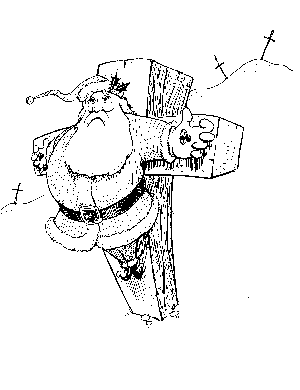
To the ancients, seeing the sun seem to sink lower in the sky each day through the long autumn months must have been a frightening experience! What if the sun simply disappeared beneath the horizon? What if the winter continued indefinitely? It would mean the end of life for all creatures.
At the winter solstice, the sun seems to "stand still" in the sky for a couple of days. (The word solstice literally means "sun standing" in Latin.)
Three days after the solstice (by today's calendar, that's December 25), the sun starts to rise again in the sky. This is the Jul (pronounced "Yule"), the turning of the sun.
It was a time of rejoicing because it meant the winter would eventually end and the summer return.
In various cultures, it was honored in different ways.
To the Romans, it was the rebirth of the sun, or Sol Invictus (the "unconquerable sun"). Among the Mithraists of ancient Rome (Mithras was a Persian import and a solar deity), the sun-god was born each December 25, to collect his 12 disciples (the signs of the Zodiac) and to walk upon the earth again. (Sound familiar?)
In Scandinavian countries, the deity involved was usually Thor (see Who Was the Real Santa Claus), the god of fire, of lightning and, of course, of the sun.
To many ancients, this was the festival of the rebirth of the Mother Earth. Winter was the time of the male god, stern and threatening, and the rebirth of the Goddess brought hope again in the midst of the winter.
Festivities during the Yule holiday always involved feasting and general merriment. The anglo-saxon word for December was geol, "feast-month." Pronounced much like Yule, it was probably influenced by the name of the holiday itself.
Preserved foods, of course, were featured (in the middle of winter!) so that fruitcake you got last year from Aunt Martha was in the true spirit of the holidays.
Gift-giving was also featured, particularly to the children. In fact, children seem to have been honored at Yule since earliest times. (Most likely because it honored the "birth" of the god or goddess, and children reflected new life within themselves.)
Also featured were evergreen trees, boughs and wreaths. Wreaths were especially important because they were images of the sun itself (round with the leaves or pine needles symbolic of the sun's rays.)
Mistletoe, with its bright red berries, and holly, with its rich green leaves, were especially sacred at Yuletide. Mistletoe was seen to be a symbol of birth and fertility (living in the sacred oak), so pledges of troth under the mistletoe were especially potent! (Kissing a person under the mistletoe originally meant a child would be born within nine months, "kissing" being a euphemism for love-making!)
Also important at Yule were the lights. Candles, fires, burning logs -- all were present at Yule. Most likely, Hannukah was originally a solar festival of lights, before a more political meaning was attached to it.
Yule was a time for people to come together in peace; share food together; share personal items through gift-giving; and to honor the potential end of winter and the coming again of spring time.
All of the modern trappings of the season, food, gifts, trees, lights, mistletoe, wreaths, and conviviality, have been used to honor the Yuletide for thousands of years.
This is the real meaning of the season!